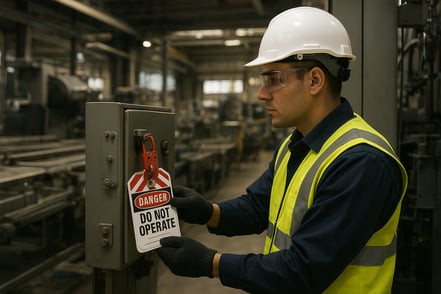Introduction
Aviation is an industry that operates under an unforgiving standard of precision. From mechanics and maintenance crews to flight attendants and first officers, every role depends on rigorous, consistent training. Mistakes are not simply costly—they can be catastrophic.
However, training in aviation remains hindered by legacy methods: paper-based SOPs, classroom lectures, and expensive, inflexible simulators that are often booked months in advance. These modalities, while familiar, fall short in preparing modern workforces for the complexity and variability of real-world operations.
In recent years, Virtual Reality (VR) has emerged as a transformational tool for aviation training. No longer reserved for high-end pilot simulators, VR is now accessible, customizable, and—critically—scalable across all aviation sub-verticals. This shift has been accelerated by no-code platforms like Facilitate, which enable training teams to build immersive simulations internally, without the need for developers or expensive outsourcing.
The Growing Complexity of Aviation Training Needs
The aviation sector, which encompasses airlines, MRO (Maintenance, Repair & Overhaul) providers, airports, training institutions, and regulatory bodies, is facing several compounding challenges:
- An aging and retiring workforce, leading to a loss of institutional knowledge.
- A global shortage of skilled aviation professionals, especially in maintenance and technical roles.
- Constant evolution of aircraft systems, safety regulations, and operational protocols, demanding frequent content updates and re-certifications.
- Decentralized, multilingual teams spread across geographies and time zones, each requiring localized yet standardized training.
These pressures expose a gap that traditional training formats struggle to bridge: how do you deliver precise, contextual, hands-on learning—at scale, and with agility?
Virtual Reality: A High-Fidelity, Low-Risk Learning Environment
VR offers a unique value proposition to aviation training: it allows learners to practice complex, hazardous, or rare scenarios within an immersive and interactive simulation, without any associated safety risk or operational disruption.
Unlike video modules or PowerPoint-based eLearning, VR actively engages the learner in a contextual environment. For example, a technician can rehearse lockout/tagout (LOTO) procedures on an aircraft component, a ground crew member can identify Foreign Object Debris (FOD) in a virtual ramp inspection, and a trainee pilot can walk through a cockpit flow for an unfamiliar aircraft model.
Notably, no-code VR platforms like Facilitate remove one of the largest historical barriers to VR adoption: the need for 3D developers or technical coding skills. Now, subject matter experts (SMEs) and training managers can build interactive lessons using 360° imagery, videos, virtual role-play, and assessments—all from a browser-based interface.
Use Cases Across Aviation Sub-Verticals
The applicability of VR spans virtually every department in aviation. While not exhaustive, the following use cases illustrate how various functions can benefit:
Maintenance, Repair & Overhaul (MRO)
- Component disassembly and reassembly
- LOTO procedures and safety zone enforcement
- Aircraft type-specific maintenance walk-throughs
- Tool control and hazard identification exercises
Flight Operations & Crew Training
- Emergency evacuation simulations
- Cockpit flow rehearsals
- Crew resource management (CRM) scenarios
- Passenger conflict resolution role-play
Ground Handling & Ramp Operations
- Pushback and marshalling protocols
- Ramp hazard identification and safety audits
- Fueling and towing sequences
- Cargo and baggage handling SOPs
Aviation Training Institutions
- VR-based pre-simulator familiarization
- Accessible, asynchronous learning for remote students
- Supplementary modules to support certification programs
Each of these simulations can be localized, versioned, and rapidly updated—an essential feature in a field where operational procedures evolve quickly.
Evidence of Effectiveness
The pedagogical case for VR in aviation training is strongly supported by empirical data. Multiple studies (including those from PwC and the VR/AR Association) demonstrate that:
- VR learners complete training up to four times faster than in classroom settings.
- Knowledge retention rates in VR hover around 75–80%, significantly higher than traditional formats.
- Trainees report being 275% more confident in applying what they learned after immersive training.
- Major organizations have reported incident reductions of up to 45% after implementing VR.
For aviation, these figures are particularly impactful when tied to reduced downtime, fewer regulatory violations, and a more resilient workforce.
Scalability, Accessibility, and Compliance
Facilitate’s no-code platform is designed with aviation in mind. It supports deployment on:
- Standalone VR headsets (Meta Quest, Pico Neo, Vive Focus)
- Desktop and laptop delivery, allowing teams without VR headsets to access simulations
- SCORM/xAPI integrations, ensuring compatibility with existing Learning Management Systems (LMS)
- Multi-language configurations for global workforces
Training data, completion records, and assessment outcomes are captured in real-time, supporting both internal performance tracking and regulatory audit readiness.
Conclusion
In aviation, precision, safety, and speed are non-negotiable. As the industry evolves, so must the methods we use to train the individuals who keep it running. No-code VR training offers a scalable, flexible, and effective solution for preparing aviation professionals to meet the challenges of today—and tomorrow.
By democratizing immersive content creation, platforms like Facilitate are making it possible for internal teams to build, update, and deploy scenario-based training at the speed of operational change. Whether preparing a new hire for their first engine inspection or training a seasoned pilot on new emergency protocols, VR offers the fidelity of experience without the risk.
Call to Action
If your aviation organization is ready to enhance safety, shorten onboarding, and ensure compliance with modern training demands, now is the time to explore no-code VR.
📅 Book a personalized demo with Facilitate to see how immersive simulation can lift your training program off the ground—no developers required.




Comments